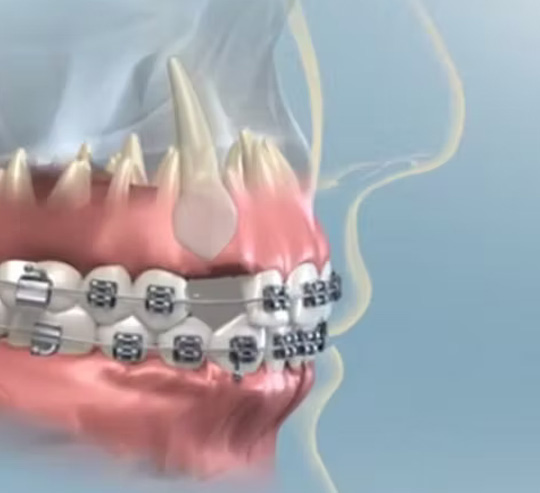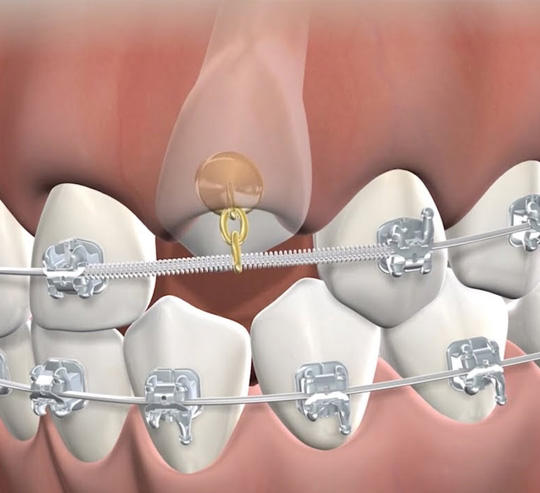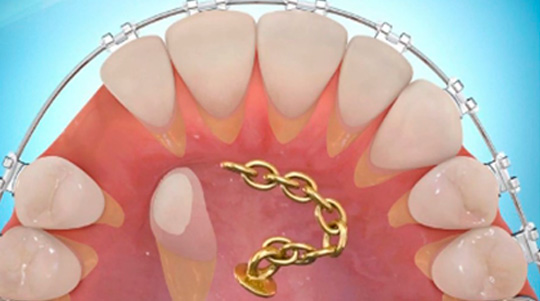Advanced Dental Scarsdale Oral Surgery
exposure of impacted canines
An impacted tooth simply means that it is stuck and cannot erupt into function.
Patients frequently develop problems with impacted third molar - wisdom teeth. These teeth get stuck in the back of the jaw and can develop painful infections among a host of other problems.
The maxillary canine (cuspid or upper eyetooth) is the second most common tooth to become impacted.

Sixty percent of these impacted canines are located on the palatal (roof of the mouth) side of the dental arch. The remaining impacted canines are found in the middle of the supporting bone but stuck in an elevated position above the roots of the adjacent teeth or out to the facial side of the dental arch.
The canine tooth is a critical tooth in the dental arch and plays an important role in your bite. The canine teeth are very strong biting teeth and have the longest roots of any human teeth. They are designed to be the first teeth that touch when your jaws close together so they guide the rest of the teeth into the proper bite.
Normally, the maxillary canine teeth are the last of the front teeth to erupt into place. They usually come into place around age 13 and cause any space left between the upper front teeth to close tighter together.
If a canine tooth gets impacted, every effort is made to get it to erupt into its proper position in the dental arch. The techniques involved to aid eruption can be applied to any impacted tooth in the upper or lower jaw, but most commonly they are applied to the maxillary canine (upper eye) teeth.
Exposure And Bracketing Of An Impacted Canine (Cuspid)
Surgical Exposure of Unerupted Teeth for
orthodontic purposes. Once the tooth is exposed,
the oral surgeon bonds an orthodontic bracket to
the exposed tooth.
The bracket has a miniature gold chain attached to it.

In cases where the canines will not erupt spontaneously, the orthodontist and oral surgeon work together to get these unerupted canines to erupt.
Each case must be evaluated on an individual basis but treatment will usually involve a combined effort between the orthodontist and the oral surgeon.
The Most Common Scenario Will Call For The Orthodontist To:
- place braces on the teeth (at least the upper arch).
-A space will be opened to provide room for the impacted tooth to be moved into its proper position in the dental arch. If the baby canine has not fallen out already, it is usually left in place until the space for the adult canine is ready.
-Once the space is ready, the orthodontist will refer the patient to the oral surgeon to have the impacted canine exposed and bracketed.

In a simple surgical procedure performed in the surgeons office, the gum on top of the impacted tooth will be lifted up to expose the hidden tooth underneath. If there is a baby tooth present, it will be removed at the same time. Once the tooth is exposed, the oral surgeon will bond an orthodontic bracket to the exposed tooth. The bracket will have a miniature gold chain attached to it.
The oral surgeon will guide the chain back to the orthodontic arch wire where it will be temporarily attached. Sometimes the surgeon will leave the exposed impacted tooth completely uncovered by suturing the gum up high above the tooth or making a window in the gum covering the tooth (on selected cases located on the roof of the mouth). Most of the time, the gum will be returned to its original location and sutured back with only the chain remaining visible as it exits a small hole in the gum.
After Surgery
Shortly after surgery (1-14 days) the patient will return to the orthodontist. A rubber band will be attached to the chain to put a light eruptive pulling force on the impacted tooth.
This will begin the process of moving the tooth into its proper place in the dental arch.
This is a carefully controlled, slow process that may take up to a full year to complete.
The goal is to erupt the impacted tooth and not to extract it!
How to prepare for Oral Surgery

Once the tooth is moved into the arch in its final position, the gum around it will be evaluated to make sure it is sufficiently strong and healthy to last for a lifetime of chewing and tooth brushing. In some circumstances, especially those where the tooth had to be moved a long distance, there may be some minor "gum surgery" required to add bulk to the gum tissue over the relocated tooth so it remains healthy during normal function. Advanced Scarsdale orthodontist will explain this situation to you if it applies to your specific situation.
Once the teeth are removed, the gum is sutured. To help control bleeding, gauze is placed in your mouth.
You will rest under our supervision in the office until you are ready to be taken home. Upon discharge, your postoperative kit will include postoperative instructions, a prescription for pain medication, antibiotics, and a follow-up appointment in one week.
what to expect from surgery to expose and bracket an impacted tooth?
The surgery to expose and bracket an impacted tooth is a very straight forward surgical procedure. In most cases it will be performed with local anesthesia or under I.V. sedation. This is generally necessary for this procedure as most of the patients requiring this procedure are under the age of 10. The procedure is generally scheduled for 45 minutes if one tooth is being exposed and bracketed and one hour if both sides require treatment.
To schedule an appointment with an Oral surgeon please contact Advanced Dental Scarsdale Oral Surgery:
Call Us : (914) 874-5757, 130 Garth Road Scarsdale, NY 10583